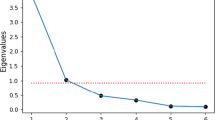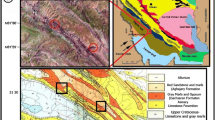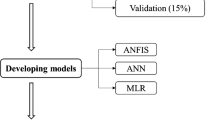Abstract
Engineering properties of rocks such as unconfined compressive strength (UCS) and Young’s modulus (E) are among the essential parameters for the design of tunnel excavations. Many attempts have been made to develop indirect methods of estimating UCS and E. This is generally attributed to the difficulty of preparing and conducting the aforementioned tests in a laboratory. In essence, this study aims to present two predictive models of UCS and E for granite using an adaptive neuro-fuzzy inference system (ANFIS). The required rock samples for model development (45 granite sample sets) were obtained from site investigation work at the Pahang-Selangor raw water transfer tunnel, which was excavated across the Main Range of Peninsular Malaysia. In developing the predictive models, dry density, ultrasonic velocity, quartz content and plagioclase were set as model inputs. These parameters were selected based on simple and multiple regression analyses presented in the article. However, for the sake of comparison, the prediction performances of the ANFIS models were checked against multiple regression analysis (MRA) and artificial neural network (ANN) predictive models of UCS and E. The capacity performances of the predictive models were assessed based on the value account for (VAF), root mean squared error (RMSE) and coefficient of determination (R 2). It was found that the ANFIS predictive model of UCS, with R 2, RMSE and VAF equal to 0.985, 6.224 and 98.455 %, respectively, outperforms the MRA and ANN models. A similar conclusion was drawn for the ANFIS predictive model of E where the values of R 2, RMSE and VAF were 0.990, 3.503 and 98.968 %, respectively.













Similar content being viewed by others
References
Alvarez GM, Babuska R (1999) Fuzzy model for the prediction of unconfined compressive strength of rock samples. Int J Rock Mech Min Sci 36:339–349
Asadi M, Hossein Bagheripour M, Eftekhari M (2013) Development of optimal fuzzy models for predicting the strength of intact rocks. Comput Geosci 54:107–112
Atici U (2011) Prediction of the strength of mineral admixture concrete using multivariable regression analysis and an artificial neural network. Expert Syst Appl 38:9609–9618
Basu A, Aydin A (2006) Predicting uniaxial compressive strength by point load test: significance of cone penetration. Rock Mech Rock Eng 39:483–490
Beiki M, Majdi A, Givshad AD (2013) Application of genetic programming to predict the uniaxial compressive strength and elastic modulus of carbonate rocks. Int J Rock Mech Min Sci 63:159–169
Ceryan N, Okkan U, Kesimal A (2012) Prediction of unconfined compressive strength of carbonate rocks using artificial neural networks. Environ Earth Sci 68(3):807–819
Cevik A, Sezer EA, Cabalar AF, Gokceoglu C (2011) Modeling of the uniaxial compressive strength of some clay-bearing rocks using neural network. Appl Soft Comput 11(2):2587–2594
Cobanglu I, Celik S (2008) Estimation of uniaxial compressive strength from point load strength, Schmidt hardness and P-wave velocity. Bull Eng Geol Environ 67:491–498
Dehghan S, Sattari GH, Chehreh CS, Aliabadi MA (2010) Prediction of unconfined compressive strength and modulus of elasticity for Travertine samples using regression and artificial neural networks. Min Sci Technol 20:0041–0046
Dreyfus G (2005) Neural networks: methodology and application. Springer, Berlin
Garret JH (1994) Where and why artificial neural networks are applicable in civil engineering. J Comput Civil Eng 8:129–130
Gokceoglu C (2002) A fuzzy triangular chart to predict the uniaxial compressive strength of the Ankara agglomerates from their petrographic composition. Eng Geol 66(1):39–51
Gokceoglu C, Zorlu K (2004) A fuzzy model to predict the unconfined compressive strength and modulus of elasticity of a problematic rock. Eng Appl Artif Intell 17:61–72
Gokceoglu C, Yesilnacar E, Sonmez H, Kayabasi A (2004) Aneurofuzzy model for modulus of deformation of jointed rock masses. Comput Geotech 31(5):375–383
Grima MA, Bruines PA, Verhoef PNW (2000) Modeling tunnel boring machine performance by neuro-fuzzy methods. Tunn Undergr Space Technol 15(3):260–269
Hajihassani M, Jahed Armaghani D, Sohaei H, Tonnizam Mohamad E, Marto A (2014) Prediction of airblast-overpressure induced by blasting using a hybrid artificial neural network and particle swarm optimization. Appl Acoust 80:57–67
Hecht-Nielsen R (1987) Kolmogorov’s mapping neural network existence theorem. In: Proceedings of the first IEEE international conference on neural networks, San Diego CA, USA, pp 11–14
Hornik K, Stinchcombe M, White H (1989) Multilayer feedforward networks are universal approximators. Neural Netw 2:359–366
Iphar M, Yavuz M, Ak H (2008) Prediction of ground vibrations resulting from the blasting operations in an open-pit mine by adaptive neuro-fuzzy inference system. Environ Geol 56:97–107
ISRM (2007) The complete ISRM suggested methods for rock characterization, testing and monitoring: 1974–2006. In: Ulusay R, Hudson JA (eds) Suggested methods prepared by the commission on testing methods, International Society for Rock Mechanics
Jahed Armaghani D, Hajihassani M, Yazdani Bejarbaneh B, Marto A, Tonnizam Mohamad E (2014) Indirect measure of shale shear strength parameters by means of rock index tests through an optimized artificial neural network. Measurement 55:487–498
JahedArmaghani D, Hajihassani M, Mohamad ET, Marto A, Noorani SA (2013) Blasting-induced flyrock and ground vibration prediction through an expert artificial neural network based on particle swarm optimization. Arab J Geosci. doi:10.1007/s12517-013-1174-0
Jang RJS (1993) Anfis: adaptive-network-based fuzzy inference system. IEEE Trans Syst Man Cybern 23:665–685
Jang RJS, Sun CT, Mizutani E (1997) Neuro-fuzzy and soft computing. Prentice-Hall, Upper Saddle River, p 614
Kaastra I, Boyd M (1996) Designing a neural network for forecasting financial and economic time series. Neurocomputing 10:215–236
Kahraman S (2001) Evaluation of simple methods for assessing the uniaxial compressive strength of rock. Int J Rock Mech Min Sci 38:981–994
Kahraman S (2014) The determination of uniaxial compressive strength from point load strength for pyroclastic rocks. Eng Geol 170:33–42
Kahraman S, Fener M, Kozman E (2012) Predicting the compressive and tensile strength of rocks from indentation hardness index. J S Afr Inst Min Metall 112(5):331–339
Kanellopoulas I, Wilkinson GG (1997) Strategies and best practice for neural network image classification. Int J Remote Sens 18:711–725
Karaman K, Kesimal A (2014) A comparative study of Schmidt hammer test methods for estimating the uniaxial compressive strength of rocks. Bull Eng Geol Environ. doi:10.1007/s10064-014-0617-5
Kosko B (1994) Neural networks and fuzzy systems: a dynamical systems approach to machine intelligence. Prentice Hall, New Delhi
Majdi A, Beiki M (2010) Evolving neural network using a genetic algorithm for predicting the deformation modulus of rock masses. Int J Rock Mech Min Sci 47(2):246–253
Marto A, Hajihassani M, Jahed Armaghani D, Tonnizam Mohamad E, Makhtar AM (2014) A novel approach for blast-induced flyrock prediction based on imperialist competitive algorithm and artificial neural network. Sci World J. Article ID 643715
Masters T (1994) Practical neural network recipes in C++. Academic Press, Boston
Meulenkamp F, Grima MA (1999) Application of neural networks for the prediction of the unconfined compressive strength (UCS) from Equotip hardness. Int J Rock Mech Min Sci 36(1):29–39
Mishra DA, Basu A (2013) Estimation of uniaxial compressive strength of rock materials by index tests using regression analysis and fuzzy inference system. Eng Geol 160:54–68
Momeni E, Nazir R, JahedArmaghani D, Maizir H (2014a) Prediction of pile bearing capacity using a hybrid genetic algorithm-based ANN. Measurement 57:122–131
Momeni E, Jahed Armaghani D, Hajihassani M, Mohd Amin MF (2014b) Prediction of uniaxial compressive strength of rock samples using hybrid particle swarm optimization-based artificial neural networks. Measurement .doi:10.1016/j.measurement.2014.09.075
Monjezi M, Khoshalan HA, Razifard M (2012) A neuro-genetic network for predicting uniaxial compressive strength of rocks. Geotech Geol Eng 30(4):1053–1062
Moradian ZA, Ghazvinian AH, Ahmadi M, Behnia M (2010) Predicting slake durability index of soft sandstone using indirect tests. Int J Rock Mech Min Sci 47(4):666–671
Nazir R, Momeni E, Jahed Armaghani D, Mohd Amin MF (2013a) Correlation between unconfined compressive strength and indirect tensile strength of limestone rock samples. Electr J Geotech Eng 18:1737–1746
Nazir R, Momeni E, JahedArmaghani D, Mohd Amin MF (2013b) Prediction of unconfined compressive strength of limestone rock samples using L-type Schmidt hammer. Electr J Geotech Eng 18:1767–1775
O’Rourke JE (1989) Rock index properties for geoengineering in underground development. Miner Eng 106–110
Rabbani E, Sharif F, KoolivandSalooki M, Moradzadeh A (2012) Application of neural network technique for prediction of uniaxial compressive strength using reservoir formation properties. Int J Rock Mech Min Sci 56:100–111
Rezaei M, Majdi A, Monjezi M (2012) An intelligent approach to predict unconfined compressive strength of rock surrounding access tunnels in longwall coal mining. Neural Comput Appl 24(1):233–241
Ripley BD (1993) Statistical aspects of neural networks. In: Barndoff-Neilsen OE, Jensen JL, Kendall WS (eds) Networks and chaos-statistical and probabilistic aspects. Chapman & Hall, London, pp 40–123
Sezer EA, Nefeslioglu HA, Gokceoglu C (2014) An assessment on producing synthetic samples by fuzzy C-means for limited number of data in prediction models. Appl Soft Comput 24:126–134
Simpson PK (1990) Artificial neural system: foundation, paradigms, applications and implementations. Pergamon, New York
Singh RN, Hassani FP, Elkington PAS (1983) The application of strength and deformation index testing to the stability assessment of coal measures excavations. In: Proceeding of 24th US symposium on rock mechanism, Texas A and M Univ. AEG, Balkema, Rotterdam, pp 599–609
Singh VK, Singh D, Singh TN (2001) Prediction of strength properties of some schistose rocks from petrographic properties using artificial neural networks. Int J Rock Mech Min Sci 38(2):269–284
Singh R, Kainthola A, Singh TN (2012) Estimation of elastic constant of rocks using an ANFIS approach. Appl Soft Comput 12(1):40–45
Sonmez H, Gokceoglu C (2008) Discussion on the paper by H. Gullu and E. Ercelebi, “A neural network approach for attenuation relationships: an application using strong ground motion data from Turkey. Eng Geol 97:91–93
Sonmez H, Tuncay E, Gokceoglu C (2004) Models to predict the uniaxial compressive strength and the modulus of elasticity for Ankara Agglomerate. Int J Rock Mech Min Sci 41(5):717–729
Sonmez H, Gokceoglu C, Nefeslioglu HA, Kayabasi A (2006) Estimation of rock modulus: for intact rocks with an artificial neural network and for rock masses with a new empirical equation. Int J Rock Mech Min Sci 43:224–235
Sulukcu S, Ulusay R (2001) Evaluation of the block punch index test with particular reference to the size effect, failure mechanism and its effectiveness in predicting rock strength. Int J Rock Mech Min Sci 38:1091–1111
Takagi T, Sugeno M (1985) Fuzzy identification of systems and its applications to modeling and control. IEEE Trans Syst Man Cybern 15:116–132
Tandon RS, Gupta V (2014) Estimation of strength characteristics of different Himalayan rocks from Schmidt hammer rebound, point load index, and compressional wave velocity. Bull Eng Geol Environ. doi:10.1007/s10064-014-0629-1
Tawadrous AS, Katsabanis PD (2007) Prediction of surface crown pillar stability using artificial neural networks. Int J Numer Anal Method 31(7):917–931
Tonnizam Mohamad E, Jahed Armaghani D, Momeni E, Alavi Nezhad Khalil Abad SV (2014) Prediction of the unconfined compressive strength of soft rocks: a PSO-based ANN approach. Bull Eng Geol Environ. doi:10.1007/s10064-014-0638-0
Wang C (1994) A theory of generalization in learning machines with neural application. PhD thesis, The University of Pennsylvania, USA
Yagiz S (2011) Correlation between slake durability and rock properties for some carbonate rocks. Bull Eng Geol Environ 70(3):377–383
Yagiz S, Sezer EA, Gokceoglu C (2012) Artificial neural networks and nonlinear regression techniques to assess the influence of slake durability cycles on the prediction of uniaxial compressive strength and modulus of elasticity for carbonate rocks. Int J Numer Anal Method 36(14):1636–1650
Yasar E, Erdogan Y (2004) Estimation of rock physiomechanical properties using hardness methods. Eng Geol 71:281–288
Yesiloglu-Gultekin N, Gokceoglu C, Sezer EA (2013) Prediction of uniaxial compressive strength of granitic rocks by various nonlinear tools and comparison of their performances. Int J Rock Mech Min Sci 62:113–122
Yilmaz I, Sendir H (2002) Correlation of Schmidt hardness with unconfined compressive strength and Young’s modulus in gypsum from Sivas (Turkey). Eng Geol 66(3):211–219
Yilmaz I, Yuksek G (2009) Prediction of the strength and elasticity modulus of gypsum using multiple regression, ANN, and ANFIS models. Int J Rock Mech Min Sci 46(4):803–810
Zorlu K, Gokceoglu C, Ocakoglu F, Nefeslioglu HA, Acikalin S (2008) Prediction of uniaxial compressive strength of sandstones using petrography-based models. Eng Geol 96(3):141–158
Acknowledgments
The authors would like to extend their sincere gratitude to the Pahang-Selangor Raw Water Transfer Project team, especially to Ir. Dr. Zulkeflee Nordin, Ir. Arshad and contractor and consultant groups for facilitating this study. The authors would also like to express their appreciation to Universiti Teknologi Malaysia for support and making this study possible. Also, the authors are grateful to the reviewers for their constructive comments.
Author information
Authors and Affiliations
Corresponding author
Rights and permissions
About this article
Cite this article
Jahed Armaghani, D., Tonnizam Mohamad, E., Momeni, E. et al. An adaptive neuro-fuzzy inference system for predicting unconfined compressive strength and Young’s modulus: a study on Main Range granite. Bull Eng Geol Environ 74, 1301–1319 (2015). https://doi.org/10.1007/s10064-014-0687-4
Received:
Accepted:
Published:
Issue Date:
DOI: https://doi.org/10.1007/s10064-014-0687-4




